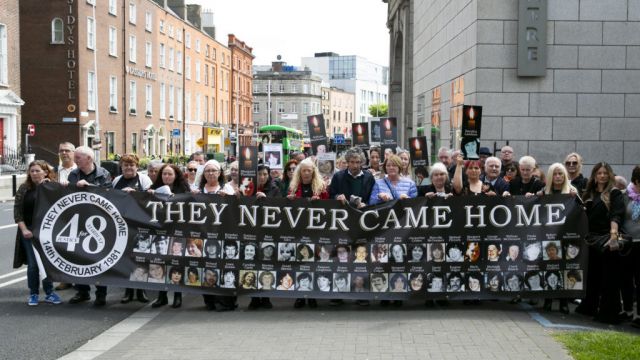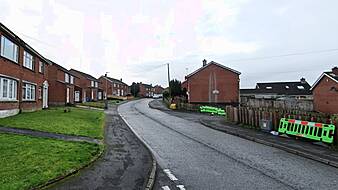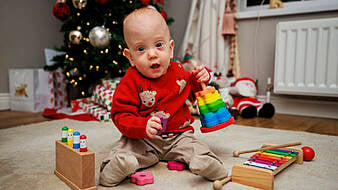A former Stardust barman has described his efforts to extinguish the fire, which seemed to grow as he did so, and his attempts to evacuate patrons who were unaware of the events unfolding close by.
In testimony that was at times emotional, Colm O’Toole told the inquest how after realising the fire could not be brought under control he tried to direct people out of the building through an exit they would have been unaware of in the dispense bar.
Mr O’Toole, who was 20 at the time, said there was “no plan in place” when the fire broke out and a small number of individuals were working to bring it under control while the music continued to play.
“It was almost like business as usual, the music was still going and people didn’t know really,” he told Des Fahy KC, representing nine of the deceased families.
Mr O’Toole’s efforts to tackle the blaze and evacuate patrons was acknowledged by a number of lawyers on Friday acting on behalf of the families of the deceased.
Extinguish fire
In his evidence to the tribunal today, Mr O’Toole, who was one of the first people to try and bring what was initially deemed to be a small fire under control, said his efforts to use the fire extinguisher to douse the flames were futile.
“It certainly wasn’t dampening the substance that was on fire,” he said. “It was almost like it was pushing it away, almost like I was separating the flame and out of one flame I was creating two flames.”
The witness agreed with Mr Fahy that his efforts to put the fire out were doomed to fail. “It had no effect on the flame,” he said.
He told Mark Tottenham SC, a member of the coroner’s legal team, that every time he sprayed water it “seemed to drive the flame on a bit more rather than put them out”.
He agreed there was a sudden change once another blind was raised.
“On a scale of 10 the heat was four when I was first at it,” he said. “It quickly rose to seven/eight. [when the other shutter was raised]. I also heard a noise… almost like a rush of hot air.”
“What I thought at the time was that when the shutter went up, it had fed the fire it had then gone up through the roof and I felt it was travelling over my head.”
Mr O’Toole said at this stage the smoke was “very black” and he was having difficulty breathing.
“I knew there wasn’t much more that I could do.”
In his original statement, read to the court on Friday, Mr O’Toole also told how when he realised the fire extinguisher was having no effect, he tried to direct people out of the building through an exit in the dispense bar that many patrons would have been unaware of.
“I tried to tell the patrons that there was an exit through the dispense bar but no one seemed to hear me,” he said. The smoke was getting very dense at this stage.”
He told the inquest today that after he left, somebody came out who had been overcome with smoke.
“I held them for a while,” he said. “I don’t know who that person was.”
Mr O’Toole became upset as he said he and others who had escaped the building went around to the front because they realised not everyone had been able to get out. He said there was concern at that stage for those that were still in there.
He told Mr Fahy he had received no fire training whatsoever. Asked how long elapsed between giving up his efforts to put out the fire and starting to make efforts to help people out of the building, Mr O’Toole said it would have been in the in the region of three minutes.
He said he came to the realisation that the fire was “out of control” and he was “trying to encourage people out”.
Out of control
“I was trying to bring people with me, how may I don’t know.”
Asked by Mr Fahy about the practice of doors being locked and chains put on them, Mr O’Toole said his recollection was that management were having problems with people getting in free of charge, with people letting their friends in and so the response was to put chains on the fire escapes.
He said when the club was being set up the chains would be unlocked but left on the push bars.
“So the policy was motivated, as you recollect it, by people getting in for free?,” Mr Fahy asked. “Yes,” the witness replied.
In his evidence on Friday, Danny Hughes said he believed the fire would be dealt with quickly, and he did not see the need to immediately evacuate the ballroom.
Mr Hughes, who had been working as a DJ in the Stardust for 10 months, told the 1981 Keane Tribunal of inquiry that he believed the fire would be dealt with in “15 seconds” and he didn’t want people to panic.
Mr Hughes said he had been the DJ for the dance competition taking place in the Stardust. He said the competition only lasted for the duration of one song; Born to be Alive by Patrick Hernandez. He said he went to give the winners their prize and Colm O’Brien took over on the decks.
The witness told the tribunal that when the fire broke out, he intended to tell Mr O’Brien to play a few more records and then inform patrons that the disco was finishing early.
Mr Hughes disagreed with Sean Guerin SC, representing a number of the families of the deceased including assistant DJ Michael Barrett who died in the blaze, that this was the wrong thing to do.
“The advice that you intended to give Mr O’Brien, had you got around to it, was to continue playing music?” Mr Guerin asked.
"Correct. Wind it up,” the witness replied.
“Well wind it up over the course of about 10 minutes isn’t that correct?”.
“Yes.”
Music
Mr Guerin quoted evidence Mr Hughes gave to the Keane Tribunal when he said: “I was going in to give Colm O’Brien instructions to play four more records. I mean about ten minutes, and to finish the dance off ten minutes earlier than usual and to tell people to be calm but Colm O’Brien took it into his head to tell them.
"I did not think that there would be a fire in the club and all that would happen was that people would panic and get cut.”
In his direct evidence on Friday, Mr Hughes said what he would have done if there hadn’t been a “visible fire” other than the fire on the seat, was to tell people the disco was finishing “a bit early” and to “take it easy” and make their way towards the door.
“That’s what I would have done,” he said.
The inquest heard further extracts of Mr Hughes’s testimony to the Keane Tribunal when he said his intention was not to evacuate the people but to tell them to be calm. “I thought that fire would be put out 15 seconds after I left the hall.”
In his direct evidence today, Mr Hughes said he thought that the people should be asked to evacuate the building slowly with two or three more records played.
“I thought the correct thing to do was to ask the patrons to leave in an orderly manner.”
“Your concern was the possibility of panic unnecessarily rather than a concern for immediately evacuation?” said Mr Guerin.
“My intention was to calm the situation down as best I could,” said Mr Hughes.
Mr Guerin put it to the witness that this was the wrong thing to do.
“That where there is a fire in a nightclub the only appropriate course is to arrange for the immediate, calm and unpanicked obviously, but the immediate evacuation of the building.”
No training for emergency
Asked if he had any comment to make on that suggestion, Mr Hughes replied: “My comment is that I didn’t want 800 people rushing for the doors all at once and to collapse on top of each other.”
“It might not unreasonably be observed Mr Hughes, that no one would want them dying in a fire either inside the building and that’s why it should have been immediately evacuated,” said Mr Guerin.
“I reject that suggestion,” Mr Hughes replied.
The DJ also confirmed to Mr Guerin that he had never received any training in what to do in the event of an emergency.
Mr Guerin suggested to the witness that in the event of a fire the sensible thing to do would be to turn off the music and instruct people on how to evacuate safely and quickly.
“I find that a difficult question to answer,” Mr Hughes replied.
In his originally statement to gardaí, Mr Hughes said after the dance competition ended, he made his way to the Silver Swan bar where he had a brief conversation with Eamon Butterly lasting about 45 seconds before someone came in to say there had been a fire.
He said he saw a “small flame” and “black smoke” coming from the back portion of the hall which was portioned off by a curtain and he saw people with fire extinguishers before Mr Butterly made a comment “they have set us on f**ing fire”.
He said he left and went around to the main entrance where he intended to tell Mr O’Brien to play some more records.
“At this stage I thought it was just people panicking unnecessarily,” he said, adding he couldn’t get in the door with the amount of people coming out.
He said he left and went back to exit three when he saw Colm O’Brien “staggering out” through the door. He said Mr O’Brien was “in a bad way”, his face was “pitch black” and he was vomiting.
Mr Hughes said he then looked up and saw “a little bit of white smoke as if someone was vaping up there”.
He said he didn’t believe the fire “was serious at all” and that’s why he planned to get Colm O’Brien to play three more records and get people out slowly.
However, he said he couldn’t get into the building because “people were barging out the front door”.
Mr Hughes said people’s faces were black and when Colm O’Brien came out his appearance “shocked me”.
He said after bringing Mr O’Brien to his mother’s house, the pair went back to the Stardust to look for Michael Barrett, who he said had been taken on by Mr O’Brien as an assistant road crew and DJ.
“At that time when we went back to the Stardust we didn’t believe anyone was dead,” he said. “We’d seen people walking into ambulances. They were walking in themselves.”
He said Colm came back to him and said the gardaí had said there was a body behind the door.
Mr Hughes said they went back to Colm O’Brien’s house and it was at that stage they heard the news on the radio describing how many people had died.
He agreed that video projectors were used sometimes as part of the show.
Asked if there was also a problem with the electrical supply, Mr Hughes said he had been told by a person hired to do the video section of the show that there was a “fluctuation” in the electrical supply.
He said the same system had been used in other venues without any issue.







